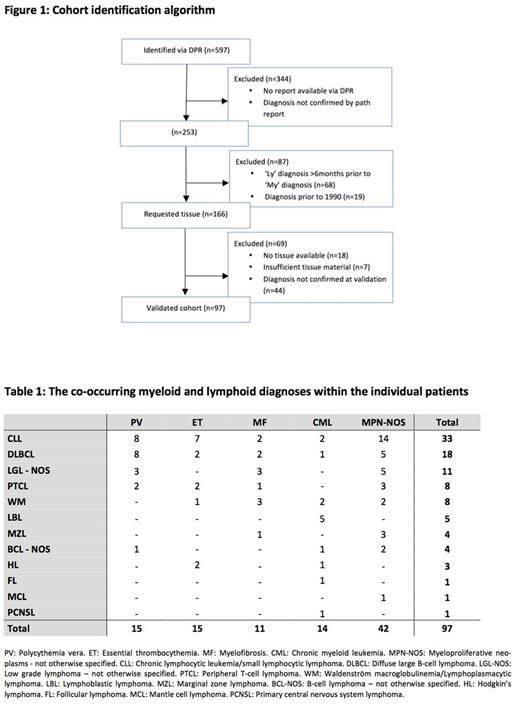Abstract
Background: So far, myeloid and lymphoid malignancies have been considered as diseases with distinct pathogenetic mechanisms. However, recent studies (Frederiksen H et al, Blood 2011) have reported an increased risk of lymphoid malignancies in patients with chronic myeloproliferative neoplasms (MPN). Moreover, genomic studies in patients with angioimmunoblastic T-cell lymphoma (AITL) have revealed mutations in epigenetic modifier genes, such as IDH-2, TET2, and DNMT3A4, which are usually not seen in lymphomas, while they are commonly found in patients with myeloid diseases.
Aim: The aim of our work was to identify and validate a nationwide cohort of patients, who were diagnosed with MPN as well as a lymphoid malignancy either simultaneously or sequentially. The establishment of this cohort is currently serving as a discovery platform for possible shared pathogenetic pathways in myeloid and lymphoid disease entities.
Methods: Patients diagnosed with both MPN and a lymphoid malignancy within the period 1990-2015 were identified through the National Danish Pathology Registry. In order to minimize the occurrence of therapy related secondary myelodysplasias, only patients diagnosed either with both diseases simultaneously (i.e. within maximum half a year from each other) or with MPN first and later with a lymphoid malignancy were selected for further histopathological revision. Formalin-fixed paraffin-embedded tissue specimens from 16 different pathology departments throughout Denmark were collected. All specimens were reviewed by an experienced hematopathologist (TLP) at a tertiary referral center.
Results: The algorithm leading to the establishment of the study cohort is shown in Figure 1. Ninety-seven patients fulfilled the described inclusion criteria. Demographically, 48.5% of the patients were females. The age at diagnosis ranged between 18.5-93.7 years and the median age at MPN diagnosis was 70.8 years (interquartile range 62.8-79.9 years). The average time between the diagnosis of MPN and that of lymphoid malignancy was 1.5 years and in the majority of the patients (90%) both diagnoses were established within 5 years from each other. The myeloid and lymphoid diagnoses for each individual patient are shown in Table 1. If one looks at mature, non-primary leukemic non-Hodgkin lymphomas, i.e. excluding lymphoblastic lymphoma, chronic lymphocytic leukemia, Waldenström macroglobulinemia, and Hodgkin lymphoma, an excess of peripheral T-cell lymphomas (PTCL) was observed (17%), at a frequency almost double as high as the one expected in a Caucasian population-based non-Hodgkin lymphoma cohort (8-10%). Interestingly, most PTCL diagnoses were of AITL type.
Conclusion: The establishment of this unique series of tissue specimens from patients with co-existing myelo- and lymphoid malignancies revealed, among primary systemic non-Hodgkin lymphomas, an excess of PTCL in general and AITL in particular. Genomic studies are ongoing to search for shared pathogenetic steps explaining the co-occurrence of MPN and lymphoid malignancies in the same host.
d'Amore: Nordic Nanovector: Other: Advisory Board; Les Laboratoires Servier: Honoraria, Other: Advisory Board; Takeda Pharma: Honoraria, Other: Advisory Board, Research Funding; Sanofi: Research Funding.
Author notes
Asterisk with author names denotes non-ASH members.


